Some of the most famous self portraits in the world of painting show more than just an artists work. They tell you about how the artist sees themself. It holds a frame of who they are at that current moment in time that no one else can make into something it is not.
Understanding these famous self-portraits is vital for any artist. They provide important insights into technique, expression, and the evolution of artistic identity.
In this blog post, we will look at some of the most renowned self portraits in painting. Also, we will explore why they remain essential aspects for aspiring and advanced artwork.
Vincent van Gogh, “Self-Portrait with Bandaged Ear” (1889)
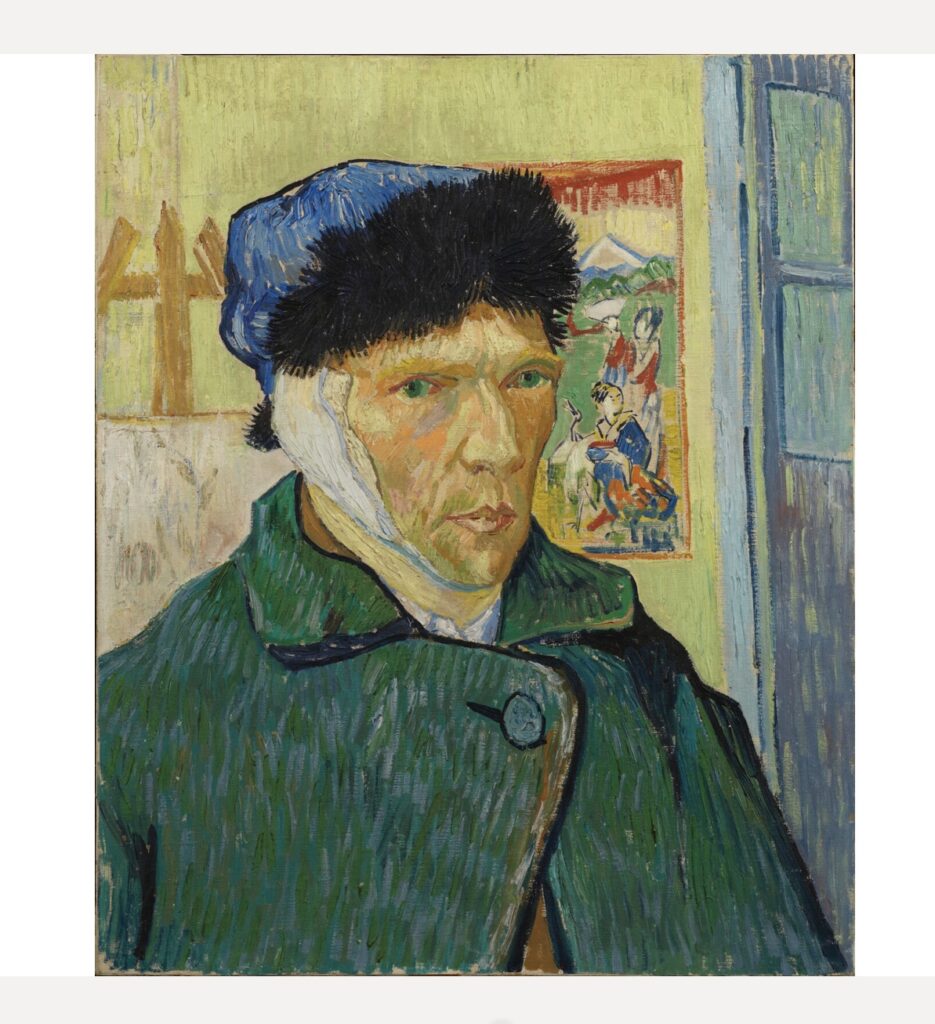
Perhaps one of the most famous portraits in oil paint ever, Vincent Van Gogh tells a story with this picture.
It was painted in January 1889, shortly after the artist famously mutilated his own ear. The painting captures van Gogh’s haunting gaze and intense psychological state. The incident with his ear has been the subject of much speculation and debate.
It is believed that Van Gogh cut off a portion of his ear during a fit of mental hallucinations. This was after a fight with fellow artist Paul Gauguin. Unfortunately, this is one of the key factors that many remember him for.
Vincent van Gogh led a hard life marked by poverty, rejection, and mental illness. Born in the Netherlands in 1853, he pursued a career in art later in life. Although, and despite his struggles, he produced a prolific body of work in just over a decade.
Van Gogh’s style evolved over time, from his early dark, somber works to his later vibrant and expressive paintings. Van Gogh’s legacy has grown amazingly since his death in 1890. This is cementing his status as one of the most influential figures in the history of art.
Looking Closer at the Paintings Details:
The Cap: we can see that Van Gogh is wearing a fur hat on his head. This painting was completed in January, so we can tell it is used to secure his bandage in place and stay warm.
The Canvas: We notice a canvas in the background on an easel. This is an incomplete work.
The Japanese Art: We can see behind Vincent some Artwork that is on display. Van Gogh took a lot of inspiration from Japanese Artwork. He stated just the year before this (1888) that most of his work to certain extents is based on Japanese work.
Rembrandt van Rijn, Self Portrait with Two Circles (1659)
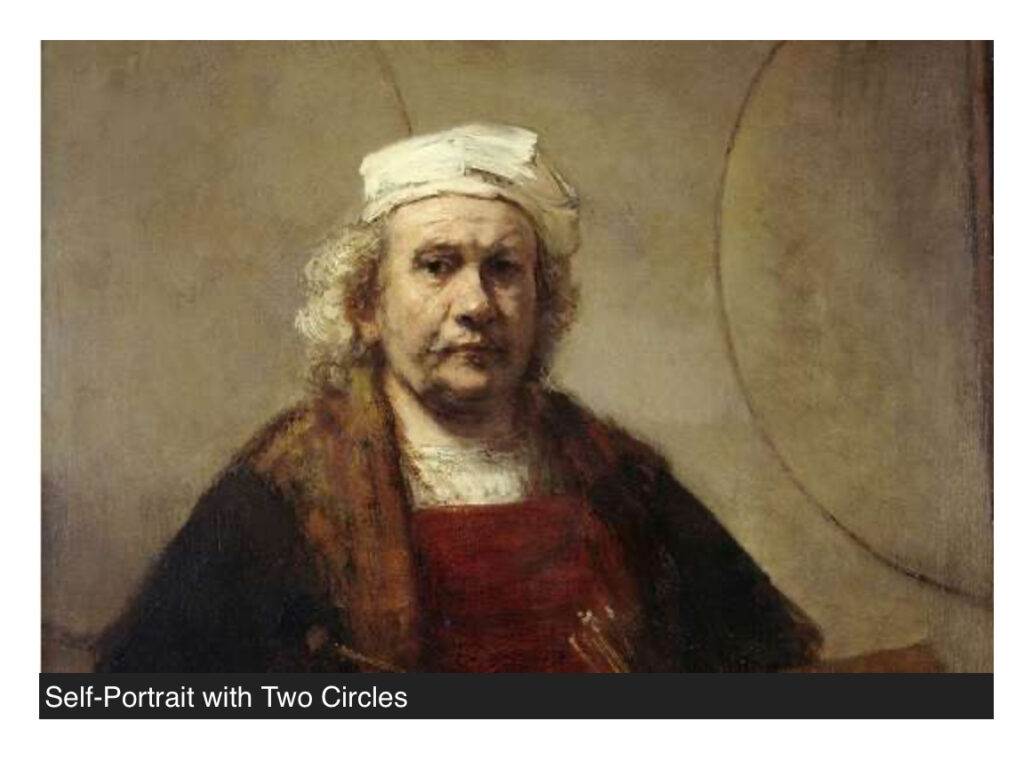
Rembrandt has one of the most famous self portraits. The painting features Rembrandt in a contemplative pose. His eyes are gazing directly at the viewer. Behind him, two loosely sketched circles suggest the outlines of a possible compositional framework. Perhaps serve as symbolic representations.
Rembrandt van Rijn (1606-1669) was a Dutch painter and printmaker. He is widely regarded as one of the greatest artists in European history. Born in Leiden, Netherlands, Rembrandt showed exceptional talent from a young age. He received formal training under various masters before establishing his own studio in Amsterdam.
Despite his artistic success, Rembrandt faced financial difficulties later in life. He ultimately declared bankruptcy in 1656. His personal life was also marked by tragedy, including the deaths of his wife and several children. Despite these challenges, Rembrandt continued to produce remarkable work until his death in 1669.
More Details About the Portrait:
One of the main focus points of this painting actually is the speculation on the background and its meaning. The painting’s composition and style depart from traditional self-portrait conventions.
Also, as Rembrandt focuses less on meticulous detail. Instead, he focuses on conveying a sense of inner depth and introspection.
The use of chiaroscuro (light and shadow) further enhances the dramatic effect of the painting. This is adding to its psychological resonance.
Frida Kahlo, “Self-Portrait with Thorn Necklace and Hummingbird” (1940)
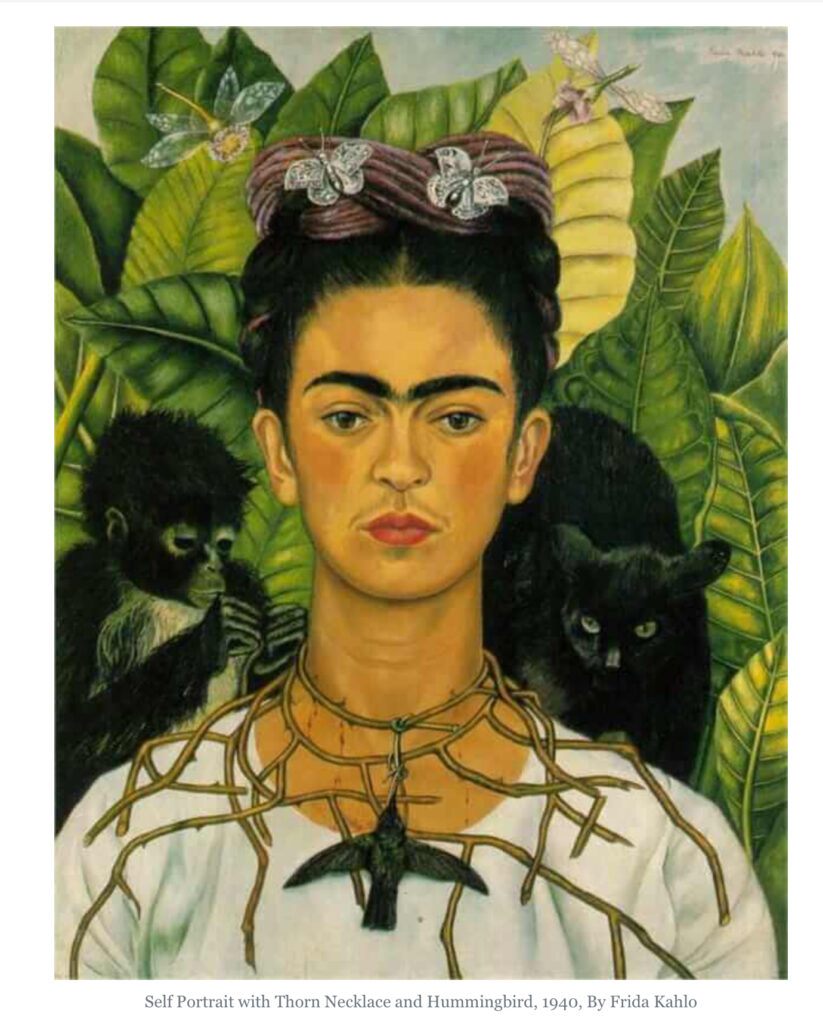
Frida has certainly some of the most famous self portraits. The painting’s rich symbolism and vibrant colors convey Kahlo’s complex inner world and her struggles with chronic pain, identity, and trauma.
Frida Kahlo (1907-1954) was a Mexican painter known for her unique and deeply personal style. Also, her exploration of themes such as identity, gender, and Mexican culture. Kahlo’s life was marked by physical and emotional challenges. This includes a near-fatal bus accident at the age of 18 that leaves her with lifelong injuries and chronic pain.
Despite these hardships, Kahlo pursues her passion for art. She began painting while recovering from her injuries. She is best known for her self-portraits, which often incorporate symbolic imagery and autobiographical elements. Kahlo’s work is deeply rooted in Mexican culture and folklore. She frequently draws inspiration from indigenous art, religious iconography, and her own personal experiences.
Details about her Self Portrait:
Thorn Necklace: In this self-portrait, Kahlo depicts herself wearing a thorn necklace, which symbolizes her physical and emotional pain. Something that is seen as beautiful such as a necklace is painful and causing harm.
Hummingbird: Hummingbirds are known to symbolize hope and resilience. In this piece, it can depict that aspect of her life and how it influences her.
Black Cat: A black cat is seen by many as a target. Besides that, an outsider. This is up for interpretation, but I believe the cat symbolizes the difference she sees in herself from others.
Baby Monkey: In this painting, the baby monkey is believed to represent the human impulse towards curiosity, mischief, and playfulness. Also, the baby monkey may also symbolize Kahlo’s own struggles with fertility and motherhood.
Pablo Picasso, “Self-Portrait” series (1901-1972)
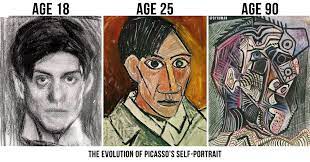
Pablo Picasso is known as one of the most important artists of the 20th century. Not only is he a founding father of modern art, but he created the cubist movement as a whole. Picasso has one of the most famous self portraits, and is known for his series of them.
One of the most important parts of Picasso’s career is his series of self-portraits. Throughout his life, Picasso creates numerous self-portraits that offer insight into his artistic style. Also, they follow his personal identity, and psychology.
His self-portraits range from realistic representations to abstract and distorted interpretations. This is reflecting his ever-changing artistic interests.
There are rumors or secrets surrounding Picasso’s self-portrait series. Also, there are several stories that have circulated over the years. However, many of them remain unsubstantiated or speculative.
One of the most famous stories is the tale of Picasso’s rivalry with fellow artist Henri Matisse. Allegedly, this fueled his desire to create a prolific series of self-portraits in an attempt to outdo his rival. However, like many legends surrounding Picasso’s life, the veracity of this story is difficult to confirm.
Another example of stories like this are with his granddaughter Marina Picasso. She knows of the neglect her father faced with his father, Pablo Picasso, but only knows so much. This leads to so much speculation.
More Details About Picasso’s Portraits from Above:
Age 18: Even at the young age of 18, Pablo is showing how loosely he draws. He clearly starts his art with mastering proportions. This piece is created with charcoal on paper.
Age 25: We can see Pablo still knows his most prominent features. His eyes remain the same shape, almond, while the rest of his face becomes more scattered. His outlines are more important than details of features.
Age 90: This painting really shows his true artistic style. By the time Picasso was 14, he was painting classically, better than all other people at the time. The older he got, the more he dove in to his own unique style.
Leonardo da Vinci, “Self-Portrait” (1512)
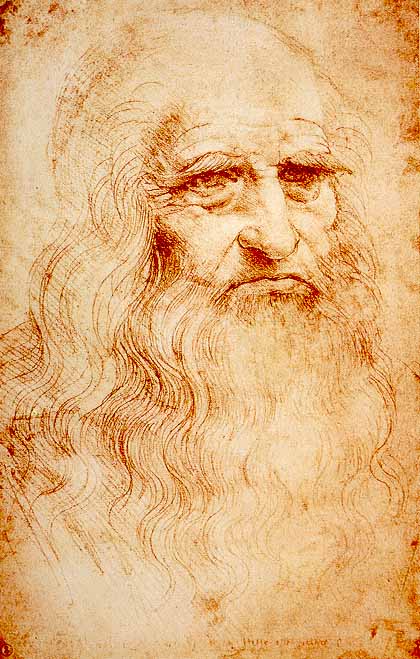
Leonardo da Vinci is one of the most famous artists of all time. He is best known for his paintings of the last supper and the Mona Lisa. Da Vinci is widely regarded as one of the most brilliant minds in human history. He is renowned for his contributions to art, science, and engineering.
Every student in United States History classes has certainly seen this portrait. It is one of the most famous self portraits to date.
Leonardo’s self-portrait is rendered in red chalk on paper. It is believed to be created around 1512 when Leonardo is in his late fifties.
The portrait is a three-quarter view, with Leonardo depicts as a man of advanced age. He has long, flowing hair and a contemplative expression. Use of red chalk allows Leonardo to capture subtle nuances of light and shadow. This is resulting in a remarkably lifelike and introspective portrayal.
Some art historians speculate that the self-portrait may be intended as a personal study. Also, it is thought to be as a gift for a friend or patron. Others suggest that Leonardo may create the self-portrait as a means of self-reflection. Perhaps, as he contemplates his own mortality and legacy in his later years.
Why DaVinci’s Portrait is so Significant
It is one of the few surviving self-portraits DaVinci created. He is famously secretive about his personal life and rarely left behind self-portraits or autobiographical documentation.
Even though we know so much about his mind, we know next to nothing about his personal interests aside from work. Therefore, this portrait provides a rare glimpse into the artist’s own appearance and psyche.
Albrecht Dürer, “Self-Portrait at 28” (1500)
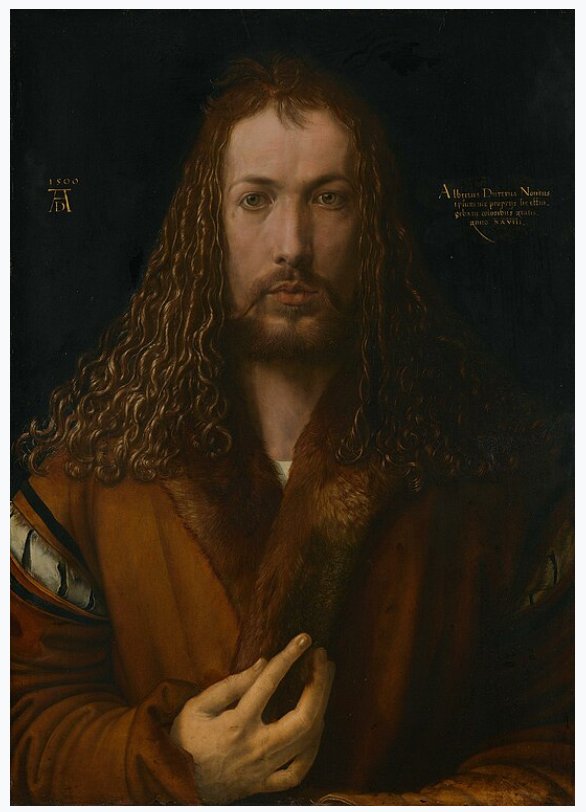
Albrecht Dürer’s “Self-Portrait at 28” is a masterpiece of Northern Renaissance art. It is painted in 1500 when Dürer was just 28 years old. While this one is not as famous as the others, it is still incredibly important.
In the art world, this is one of the most famous self portraits because of the story it tells. He took part in a massive role, creating a community in the renaissance.
“Self-Portrait at 28” is an oil-on-wood painting. This is a common medium for portraiture during the Northern Renaissance. Dürer’s use of oil paint allows him to achieve rich colors. It creates subtle gradations of light and shadow, and detail in his self-portrait.
Albrecht Dürer (1471-1528) was a German painter, printmaker, and theorist. He is widely regarded as one of the greatest artists of the Northern Renaissance. Born in Nuremberg, Germany, Dürer showed exceptional talent from a young age. Also, he received training as a goldsmith before pursuing a career in art.
Dürer made significant contributions to the art world in several ways. He was a master of various mediums, including painting, printmaking (particularly engraving and woodcut), and watercolor. He is a founding father of realism, and he is known for his sketching.
Details in Albrecht’s Portrait:
Gesture: Dürer’s hand position is particularly significant in this self-portrait. This suggests his belief in his own artistic abilities and his desire to make his mark on the world.
Timelessness: One of the main things I notice about the painting is how Albrecht still looks like someone I know. It carries a timeless element to it because of this.

Comments are closed.